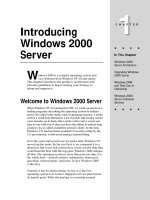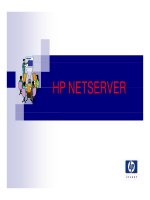Tài liệu OpenStack Cloud Computing Cookbook doc
Bạn đang xem bản rút gọn của tài liệu. Xem và tải ngay bản đầy đủ của tài liệu tại đây (5.95 MB, 318 trang )
OpenStack Cloud
Computing Cookbook
Over 100 recipes to successfully set up and manage your
OpenStack cloud environments with complete coverage
of Nova, Swift, Keystone, Glance, and Horizon
Kevin Jackson
BIRMINGHAM - MUMBAI
OpenStack Cloud Computing Cookbook
Copyright © 2012 Packt Publishing
All rights reserved. No part of this book may be reproduced, stored in a retrieval system, or
transmitted in any form or by any means, without the prior written permission of the publisher,
except in the case of brief quotations embedded in critical articles or reviews.
Every effort has been made in the preparation of this book to ensure the accuracy of the
information presented. However, the information contained in this book is sold without
warranty, either express or implied. Neither the author, nor Packt Publishing, and its dealers
and distributors will be held liable for any damages caused or alleged to be caused directly or
indirectly by this book.
Packt Publishing has endeavored to provide trademark information about all of the companies
and products mentioned in this book by the appropriate use of capitals. However, Packt
Publishing cannot guarantee the accuracy of this information.
First published: September 2012
Production Reference: 1150912
Published by Packt Publishing Ltd.
Livery Place
35 Livery Street
Birmingham B3 2PB, UK.
ISBN 978-1-84951-732-4
www.packtpub.com
Cover Image by Faiz Fattohi ()
Credits
Author
Kevin Jackson
Reviewers
Thierry Carrez
Atul Kumar Jha
Acquisition Editor
Kartikey Pandey
Lead Technical Editor
Azharuddin Sheikh
Technical Editors
Veronica Fernandes
Azharuddin Sheikh
Prasad Dalvi
Joyslita D'Souza
Copy Editor
Brandt D'Mello
Project Coordinator
Yashodhan Dere
Proofreader
Kevin McGowan
Indexer
Tejal R. Soni
Production Coordinator
Nilesh R. Mohite
Cover Work
Nilesh R. Mohite
About the Author
Kevin Jackson is married, with three children. He is an experienced IT professional working
with small businesses and online enterprises. He has extensive experience with various
avors of Linux and Unix. He specializes in web and cloud infrastructure technologies for
Trader Media Group.
I'd like to thank my wife, Charlene, and the rest of my family for their time,
patience, and encouragement throughout the book.
I'd also like to extend my thanks to the OpenStack community, which has
helped a great deal during my journey with OpenStack. The talent and
support is phenomenal. Without the OpenStack community, there would be
no OpenStack.
A specic mention goes to all those who have made this book possible.
Your comments, guidance, and motivation have made writing this book an
enjoyable experience.
About the Reviewers
Thierry Carrez is an open source project management expert and has been working on
OpenStack since 2010, as the project's Release Manager, sponsored by Rackspace.
An Ubuntu Core developer and Debian maintainer, he was previously the Technical Lead for
Ubuntu Server edition at Canonical and an Operational Manager for the Gentoo Linux Security
Team. He has also worked as an IT Manager for small and large companies.
Atul Kumar Jha has been an ardent Linux enthusiast and free software evangelist for more
than eight years. He holds an engineering degree in IT and has been working for over four
years on different job roles. He also happens to be one of the co-founders of the free software
event series called mukt.in.
He currently works as an Evangelist for CSS Corp. Pvt. Ltd., Chennai, India, where most of his
work involves free/open software technologies and cloud platforms.
He's been involved with OpenStack since the Bexar release and has been contributing to the
project since then. Most of his contributions have been around documentation, bug reporting,
and helping folks on IRC.
He can be seen lurking on Freenode, under the
#ubuntu-server or #openstack
channels, using the handle koolhead17. More information about him can be found at
.
www.PacktPub.com
Support les, eBooks, discount offers and more
You might want to visit www.PacktPub.com for support les and downloads related to
your book.
Did you know that Packt offers eBook versions of every book published, with PDF and ePub
les available? You can upgrade to the eBook version at www.PacktPub.com and as a print
book customer, you are entitled to a discount on the eBook copy. Get in touch with us at
for more details.
At www.PacktPub.com, you can also read a collection of free technical articles, sign up
for a range of free newsletters and receive exclusive discounts and offers on Packt books
and eBooks.
Do you need instant solutions to your IT questions? PacktLib is Packt's online digital book
library. Here, you can access, read and search across Packt's entire library of books.
Why Subscribe?
f Fully searchable across every book published by Packt
f Copy and paste, print and bookmark content
f On demand and accessible via web browser
Free Access for Packt account holders
If you have an account with Packt at www.PacktPub.com, you can use this to access PacktLib
today and view nine entirely free books. Simply use your login credentials for immediate access.
Table of Contents
Preface 1
Chapter 1: Starting OpenStack Compute 5
Introduction 6
Creating a sandbox environment with VirtualBox 6
Installing OpenStack Compute packages 9
Conguring database services 12
Conguring OpenStack Compute 14
Stopping and starting Nova services 17
Creating a cloudadmin account and project 19
Installation of command line-tools 20
Uploading a sample machine image 23
Launching your rst cloud instance 25
Terminating your instance 29
Chapter 2: Administering OpenStack Compute 31
Introduction 31
Creating and modifying user accounts 32
Managing security groups 34
Creating and managing keypairs 37
Using public cloud images 40
Alternative upload method using euca2ools 42
Creating custom Windows images 46
Creating custom CentOS images 49
Chapter 3: Keystone OpenStack Identity Service 55
Introduction 55
Installing OpenStack Identity Service 56
Conguring roles 57
Creating tenants 59
Adding users 60
ii
Table of Contents
Dening service endpoints 62
Conguring the service tenant and service users 67
Conguring OpenStack Image Service to use OpenStack Identity Service 70
Conguring OpenStack Compute to use OpenStack Identity Service 72
Using OpenStack Compute with OpenStack Identity Service 73
Chapter 4: Installing OpenStack Storage 77
Introduction 78
Creating an OpenStack Storage sandbox environment 78
Installing the OpenStack Storage services 82
Conguring storage 84
Conguring replication 86
Conguring OpenStack Storage Service 89
Conguring the OpenStack Storage proxy server 90
Conguring Account Server 91
Conguring Container Server 93
Conguring Object Server 95
Making the Object, Account, and Container rings 96
Stopping and starting OpenStack Storage 99
Testing OpenStack Storage 99
Setting up SSL access 102
Conguring OpenStack Storage with OpenStack Identity Service 104
Chapter 5: Using OpenStack Storage 109
Introduction 109
Installing the swift client tool 109
Creating containers 111
Uploading objects 112
Uploading large objects 113
Listing containers and objects 116
Downloading objects 117
Deleting containers and objects 118
Using OpenStack Storage ACLs 120
Chapter 6: Administering OpenStack Storage 123
Introduction 123
Preparing drives for OpenStack Storage 123
Managing the OpenStack Storage cluster with swift-init 125
Checking cluster health 126
OpenStack Storage benchmarking 128
Managing capacity 129
Removing nodes from a cluster 134
iii
Table of Contents
Detecting and replacing failed hard drives 135
Collecting usage statistics 136
Chapter 7: Glance OpenStack Image Service 141
Introduction 141
Installing OpenStack Image Service 141
Conguring OpenStack Image Service with MySQL 143
Conguring OpenStack Compute with OpenStack Image Service 144
Conguring OpenStack Image Service with OpenStack Storage 145
Managing images with OpenStack Image Service 147
Registering a remotely stored image 151
Chapter 8: Nova Volumes 153
Introduction 153
Conguring nova-volume services 154
Conguring OpenStack Compute for nova-volume 157
Creating volumes 158
Attaching volumes to instances 161
Detaching volumes from an instance 164
Deleting volumes 166
Chapter 9: Horizon OpenStack Dashboard 167
Introduction 167
Installing OpenStack Dashboard 168
Keypair management in OpenStack Dashboard 169
Security group management by using OpenStack Dashboard 174
Launching instances by using OpenStack Dashboard 178
Terminating instances by using OpenStack Dashboard 181
Connecting to instances by using OpenStack Dashboard and VNC 183
Adding new tenants by using OpenStack Dashboard 184
User management by using OpenStack Dashboard 188
Chapter 10: OpenStack Networking 195
Introduction 195
Conguring Flat networking 196
Conguring Flat networking with DHCP 198
Conguring VLAN Manager networking 201
Conguring per-project (tenant) IP ranges 203
Automatically assigning xed networks to tenants 205
Modifying a tenant's xed network 206
Manually associating oating IPs to instances 207
Manually disassociating oating IPs from instances 209
Automatically assigning oating IPs 210
iv
Table of Contents
Chapter 11: In the Datacenter 213
Introduction 213
Installing MAAS for bare-metal provisioning 214
Using MAAS for bare-metal provisioning of hosts 215
Installing and conguring Juju 219
Installing OpenStack services using Juju 220
Increasing OpenStack Compute capacity 223
MySQL clustering using Galera 225
Conguring HA Proxy for MySQL Galera load balancing 232
Increasing resilience of OpenStack services 236
Bonding network interfaces for redundancy 246
Chapter 12: Monitoring 249
Introduction 249
Monitoring Compute services with Munin 249
Monitoring instances using Munin and Collectd 255
Monitoring the storage service using StatsD/Graphite 260
Monitoring MySQL with Hyperic 265
Chapter 13: Troubleshooting 273
Introduction 273
Checking OpenStack Compute Services 273
Understanding logging 276
Troubleshooting OpenStack Compute Services 278
Troubleshooting OpenStack Storage Service 283
Troubleshooting OpenStack Authentication 284
Submitting bug reports 287
Getting help from the community 291
Index 293
Preface
OpenStack is an open source software for building public and private clouds, born from
Rackspace and NASA. It is now a global success and is developed and supported by scores
of people around the globe and backed by some of the leading players in the cloud space
today. This book is specically designed to quickly help you get up to speed with OpenStack
and give you the condence and understanding to roll it out into your own datacenters. From
test installations of OpenStack running under VirtualBox to recipes that help you move out
to production environments, this book covers a wide range of topics that help you install and
congure a private cloud. This book will show you:
f How to install and congure all the core components of OpenStack to run an
environment that can be managed and operated just like AWS, HP Cloud Services,
and Rackspace
f How to master the complete private cloud stack, from scaling out Compute resources
to managing object storage services for highly redundant, highly available storage
f Practical, real-world examples of each service built upon in each chapter, allowing you
to progress with the condence that they will work in your own environments
OpenStack Cloud Computing Cookbook gives you clear, step-by-step instructions to install
and run your own private cloud successfully. It is full of practical and applicable recipes that
enable you to use the latest capabilities of OpenStack and implement them.
Preface
2
What this book covers
Chapter 1, Starting OpenStack Compute, teaches you how to set up and use OpenStack
Compute running within a VirtualBox environment.
Chapter 2, Administering OpenStack Compute, teaches you how to manage user accounts and
security groups as well as how to deal with cloud images to run in an OpenStack environment.
Chapter 3, Keystone OpenStack Identity Service, takes you through installation and
conguration of Keystone, which underpins all of the other OpenStack services.
Chapter 4, Installing OpenStack Storage, teaches you how to congure and use OpenStack
Storage running within a VirtualBox environment.
Chapter 5, Using OpenStack Storage, teaches you how to use the storage service for storing
and retrieving les and objects.
Chapter 6, Administering OpenStack Storage, takes you through how to use tools and
techniques that can be used for running OpenStack Storage within datacenters.
Chapter 7, Glance OpenStack Image Service, teaches you how to upload and modify images
(templates) for use within an OpenStack environment.
Chapter 8, Nova Volumes, teaches you how to install and congure the persistent storage
service for use by instances running in an OpenStack Compute environment.
Chapter 9, Horizon OpenStack Dashboard, teaches you how to install and use the web
user interface to perform tasks such as creating users, modifying security groups, and
launching instances.
Chapter 10, OpenStack Networking, helps you understand the networking options currently
available as well as teaching you how to congure an OpenStack environment so that
instances are accessible on the network.
Chapter 11, In the Datacenter, takes you through understanding how to do bare-metal
provisioning, scale up OpenStack, and introduces you to adding resilience to our OpenStack
installations for high availability.
Chapter 12, Monitoring, shows you how to install and congure various open source tools for
monitoring an OpenStack installation.
Chapter 13, Troubleshooting, takes you through an understanding of the logs and where to
get help when encountering issues while running an OpenStack environment.
Preface
3
What you need for this book
To use this book, you will need access to computers or servers that have hardware
virtualization capabilities. To set up the lab environments you will need Oracle's VirtualBox
installed. You will also need access to an Ubuntu 12.04 ISO image, as the methods presented
detail steps for Ubuntu environments.
Who this book is for
This book is aimed at system administrators and technical architects moving from a
virtualized environment to cloud environments who are familiar with cloud computing
platforms. Knowledge of virtualization and managing Linux environments is expected.
Prior knowledge or experience of OpenStack is not required, although benecial.
Conventions
In this book, you will nd a number of styles of text that distinguish between different kinds of
information. Here are some examples of these styles, and an explanation of their meaning.
Code words in text are shown as follows: "Similar information is presented by the nova list
and nova show commands".
A block of code is set as follows:
bind_port = 443
cert_file = /etc/swift/cert.crt
key_file = /etc/swift/cert.key
Any command-line input or output is written as follows:
sudo apt-get update
sudo apt-get -y install qemu-kvm cloud-utils
New terms and important words are shown in bold. Words that you see on the screen, in
menus or dialog boxes for example, appear in the text like this: "In the INSTANCE section, we
get details of our running instance".
Warnings or important notes appear in a box like this.
Tips and tricks appear like this.
Preface
4
Reader feedback
Feedback from our readers is always welcome. Let us know what you think about this
book—what you liked or may have disliked. Reader feedback is important for us to develop
titles that you really get the most out of.
To send us general feedback, simply send an e-mail to , and
mention the book title through the subject of your message.
If there is a topic that you have expertise in and you are interested in either writing or
contributing to a book, see our author guide on www.packtpub.com/authors.
Customer support
Now that you are the proud owner of a Packt book, we have a number of things to help you to
get the most from your purchase.
Errata
Although we have taken every care to ensure the accuracy of our content, mistakes do
happen. If you nd a mistake in one of our books—maybe a mistake in the text or the
code—we would be grateful if you would report this to us. By doing so, you can save other
readers from frustration and help us improve subsequent versions of this book. If you nd
any errata, please report them by visiting selecting
your book, clicking on the errata submission form link, and entering the details of your
errata. Once your errata are veried, your submission will be accepted and the errata will be
uploaded to our website, or added to any list of existing errata, under the Errata section of
that title.
Piracy
Piracy of copyright material on the Internet is an ongoing problem across all media. At Packt,
we take the protection of our copyright and licenses very seriously. If you come across any
illegal copies of our works, in any form, on the Internet, please provide us with the location
address or website name immediately so that we can pursue a remedy.
Please contact us at with a link to the suspected
pirated material.
We appreciate your help in protecting our authors, and our ability to bring you
valuable content.
Questions
You can contact us at if you are having a problem with any
aspect of the book, and we will do our best to address it.
1
Starting OpenStack
Compute
In this chapter, we will cover:
f Creating a sandbox environment with VirtualBox
f Installing OpenStack Compute packages
f Conguring database services
f Conguring OpenStack Compute
f Stopping and starting Nova services
f Creating a cloudadmin account and project
f Installation of command-line tools
f Uploading a sample machine image
f Launching your rst cloud instance
f Terminating your instance
Starting OpenStack Compute
6
Introduction
OpenStack Compute, also known as Nova, is the compute component of the open source
cloud operating system, OpenStack. It is the component that allows you to run multiple
instances of virtual machines on any number of hosts running the OpenStack Compute
service, allowing you to create a highly scalable and redundant cloud environment. The open
source project strives to be hardware and hypervisor agnostic. Nova compute is analogous to
Amazon's EC2 (Elastic Compute Cloud) environment and can be managed in a similar way,
demonstrating the power and potential of this service.
This chapter gets you up to speed quickly by giving you the information you need to create a
cloud environment running entirely from your desktop machine. At the end of this chapter, you
will be able to create and access virtual machines using the same command line tools you
would use to manage Amazon's own EC2 compute environment.
Creating a sandbox environment
with VirtualBox
Creating a sandbox environment using VirtualBox allows us to discover and experiment with
the OpenStack Compute service, known as Nova. VirtualBox gives us the ability to spin up
virtual machines and networks without affecting the rest of our working environment and is
freely available from
for Windows, Mac OSX, and Linux.
This test environment can then be used for the rest of this chapter.
It is assumed the computer you will be using to run your test environment in has enough
processing power and has hardware virtualization support (modern AMDs and Intel iX
processors) with at least 4 GB RAM. Remember we're creating a virtual machine that itself
will be used to spin up virtual machines, so the more RAM you have, the better.
Getting ready
To begin with, we must download VirtualBox from and
then follow the installation procedure once this has been downloaded.
We will also need to download the Ubuntu 12.04 LTS Server ISO CD-ROM image from
/>Chapter 1
7
How to do it
To create our sandbox environment within VirtualBox, we will create a single virtual machine
that allows us to run all of the OpenStack Compute services required to run cloud instances.
This virtual machine will be congured with at least 2 GB RAM and 20 GB of hard drive
space and have three network interfaces. The rst will be a NAT interface that allows our
virtual machine to connect to the network outside of VirtualBox to download packages, a
second interface which will be the public interface of our OpenStack Compute host, and
the third interface will be for our private network that OpenStack Compute uses for internal
communication between different OpenStack Compute hosts.
Carry out the following steps to create the virtual machine that will be used to run OpenStack
Compute services:
1. In order to use a public and private network in our OpenStack environment, we rst
create these under VirtualBox. To do this, we can use the VirtualBox GUI by going
to System Preferences then Network or use the VBoxManage command from our
VirtualBox install and run the following commands in a shell on our computer to
create two HostOnly interfaces, vboxnet0 and vboxnet1:
# Public Network vboxnet0 (172.16.0.0/16)
VBoxManage hostonlyif create
VBoxManage hostonlyif ipconfig vboxnet0 ip 172.16.0.254
netmask 255.255.0.0
# Private Network vboxnet1 (10.0.0.0/8)
VBoxManage hostonlyif create
VBoxManage hostonlyif ipconfig vboxnet1 ip 10.0.0.254 netmask
255.0.0.0
2. In VirtualBox, create a new virtual machine with the following specications:
1 CPU
2048 MB
20 GB Hard Disk
Three Network Adapters, with the attached Ubuntu 12.04 ISO
This can either be done using the VirtualBox New Virtual Machine Wizard or by
running the following commands in a shell on our computer:
# Create VirtualBox Machine
VboxManage createvm name openstack1 ostype Ubuntu_64
register
VBoxManage modifyvm openstack1 memory 2048 nic1 nat
nic2 hostonly hostonlyadapter2 vboxnet0 nic3 hostonly
hostonlyadapter3 vboxnet1
Starting OpenStack Compute
8
# Create CD-Drive and Attach ISO
VBoxManage storagectl openstack1 name "IDE Controller" add ide
controller PIIX4 hostiocache on bootable on
VBoxManage storageattach openstack1 storagectl "IDE Controller"
type dvddrive port 0 device 0 medium Downloads/ubuntu-
12.04-server-amd64.iso
# Create and attach SATA Interface and Hard Drive
VBoxManage storagectl openstack1 name "SATA Controller" add
sata controller IntelAHCI hostiocache on bootable on
VBoxManage createhd filename openstack1.vdi size 20480
VBoxManage storageattach openstack1 storagectl "SATA Controller"
port 0 device 0 type hdd medium openstack1.vdi
3. We are now ready to power on our OpenStack1 node. Do this by selecting
OpenStack1 Virtual Machine and then clicking on the Start button or by
running the following command:
VBoxManage startvm openstack1 type gui
4. This will take us through a standard text-based Ubuntu installer, as this is the server
edition. Choose appropriate settings for your region and choose Eth0 as the main
interface (this is the rst interface in your VirtualBox VM settings—our NATed interface).
When prompted for software selection, just choose SSH Server and continue. For a
user, create a user named openstack and the password of openstack. This will
help with using this book to troubleshoot your own environment.
5. Once installed, log in as the openstack user.
6. We can now congure networking on our OpenStack Compute node. To do this we
will create a static address on the second interface, eth1, which will be the public
interface and also congure our host to bring up eth2 without an address, as this
interface will be controlled by OpenStack to provide the private network. To do this,
edit the /etc/network/interfaces le with the following contents:
# The loopback network interface
auto lo
iface lo inet loopback
# The primary network interface
auto eth0
iface eth0 inet dhcp
# Public Interface
auto eth1
iface eth1 inet static
address 172.16.0.1
netmask 255.255.0.0
network 172.16.0.0
broadcast 172.16.255.255
Chapter 1
9
# Private Interface
auto eth2
iface eth2 inet manual
up ifconfig eth2 up
Remember to edit the /etc/network/interfaces file
with root privileges.
7. Save the le and bring up the interfaces with the following commands:
sudo ifup eth1
sudo ifup eth2
Congratulations! We have successfully created the
VirtualBox virtual machine running Ubuntu, which is able
to run OpenStack Compute.
How it works
What we have done is created a virtual machine that is the basis of our OpenStack Compute
host. It has the necessary networking in place to allow us to access this virtual machine from
our host personal computer.
There's more
There are a number of virtualization products available that are suitable for trying OpenStack,
for example, VMware Server and VMware Player are equally suitable. With VirtualBox, you can
also script your installations using a tool named Vagrant. While outside the scope of this book,
the steps provided here allow you to investigate this option at a later date.
Installing OpenStack Compute packages
Now that we have a machine for running OpenStack, we can install the appropriate
packages for running OpenStack Compute, which will allow us to spawn its own virtual
machine instances.
To do this, we will create a machine that runs all the appropriate services for running
OpenStack Nova. The services are as follows:
f nova-compute: The main package for running the virtual machine instances
f nova-scheduler: The scheduler picks the server for fullling the request to run
the instance
Starting OpenStack Compute
10
f nova-api: Service for making requests to OpenStack to operate the services within
it; for example, you make a call to this service to start up a new Nova instance
f nova-network: Network service that controls DHCP, DNS, and Routing
f nova-objectstore: File storage service
f nova-common: Common Python libraries that underpin all of the
OpenStack environment
f nova-cert: The Nova certicate management service, used for authentication
to Nova
f glance: Image Registry and Delivery service
f rabbitmq-server: Message queue service
f mysql-server: Database server that holds the data for all OpenStack services such
as Compute nodes available, instances running, state, and so on
f ntp: Network Time Protocol is essential in a multi-node environment and that the
nodes have the same time (tolerance is within ve seconds and outside of this you
get unpredictable results)
f dnsmasq: DNS forwarder and DHCP service that allocates the addresses to your
instances in your environment
Getting ready
Ensure that you are logged in to the openstack1 VirtualBox virtual machine as the
openstack user.
How to do it
Installation of OpenStack under Ubuntu 12.04 is simply achieved using the familiar apt-get
tool due to the OpenStack packages being available from the ofcial Ubuntu repositories.
1. We can install the required packages with the following command:
sudo apt-get update
sudo apt-get -y install rabbitmq-server nova-api nova-objectstore
nova-scheduler nova-network nova-compute nova-cert glance qemu
unzip
2. Once the installation has completed, we need to install and congure NTP as follows:
sudo apt-get -y install ntp
Chapter 1
11
3. NTP is important in any multi-node environment and in the OpenStack environment it
is a requirement that server times are kept in sync. Although we are conguring only
one node, not only will accurate time-keeping help with troubleshooting, but also it
will allow us to grow our environment as needed in the future. To do this we edit
/etc/ntp.conf with the following contents:
# Replace ntp.ubuntu.com with an NTP server on your network
server ntp.ubuntu.com
server 127.127.1.0
fudge 127.127.1.0 stratum 10
4. Once ntp has been congured correctly we restart the service to pick up the change:
sudo service ntp restart
How it works
Installation of OpenStack Nova from the main Ubuntu package repository represents a very
straightforward and well-understood way of getting OpenStack onto our Ubuntu server. This
adds a greater level of certainty around stability and upgrade paths by not deviating away
from the main archives.
There's more
There are various ways to install OpenStack, from source code building to installation from
packages, but this represents the easiest and most consistent method available. There are
also alternative releases of OpenStack available. The ones available from Ubuntu 12.04 LTS
repositories are known as Essex and represent the latest stable release at the time of writing.
Using an alternative release
Deviating from stable releases is appropriate when you are helping develop or debug
OpenStack, or require functionality that is not available in the current release. To enable
different releases, add different Personal Package Archives (PPA) to your system.
To view the OpenStack PPAs, visit To use them
we rst install a pre-requisite tool that allows us to easily add PPAs to our system:
sudo apt-get update
sudo apt-get -y install python-software-properties
Starting OpenStack Compute
12
To use a particular release PPA we issue the following commands:
f For Milestones (periodic releases leading up to a stable release):
sudo add-apt-repository ppa:openstack-ppa/milestone
sudo apt-get update
f For Bleeding Edge (Master Development Branch):
sudo add-apt-repository ppa:openstack-ppa/bleeding-edge
sudo apt-get update
Once you have congured apt to look for an alternative place for packages, you can repeat
the preceding process for installing packages if you are creating a new machine based on a
different package set, or simply type:
sudo apt-get upgrade
This will make apt look in the new package archive areas for later releases of packages
(which they will be as they are more recent revisions of code and development).
Conguring database services
OpenStack supports a number of database backends—an internal Sqlite database (the
default), MySQL, and Postgres. Sqlite is used only for testing and is not supported or used
in a production environment, whereas MySQL or Postgres is down to the experience of the
database staff. For the remainder of this book we shall use MySQL.
Setting up MySQL is easy and allows for you to grow this environment as you progress through
the chapters of this book.
Getting ready
Ensure that you are logged in to the openstack1 VirtualBox virtual machine as the
openstack user.
How to do it
1. We rst set some options to pre-seed our installation of MySQL to streamline the
process. This includes the default root password which we'll set as openstack.
Complete this step as the root user.
cat <<MYSQL_PRESEED | debconf-set-selections
mysql-server-5.1 mysql-server/root_password password openstack
mysql-server-5.1 mysql-server/root_password_again password
openstack
mysql-server-5.1 mysql-server/start_on_boot boolean true
MYSQL_PRESEED
Chapter 1
13
The steps outlined previously allow for a non-interactive installation
of MySQL. You can omit this step, but during installation, it will ask
for the root password. If you do opt for an interactive install, set
openstack as the password for the root user.
2. We can now install and run MySQL by executing the following commands:
sudo apt-get update
sudo apt-get -y install mysql-server
sudo sed -i 's/127.0.0.1/0.0.0.0/g' /etc/mysql/my.cnf
sudo service mysql restart
3. Once that's done we then congure an appropriate database user, called nova, and
privileges for use by OpenStack Compute.
MYSQL_PASS=openstack
mysql -uroot -p$MYSQL_PASS -e 'CREATE DATABASE nova;'
mysql -uroot -p$MYSQL_PASS -e "GRANT ALL PRIVILEGES ON nova.* TO
'nova'@'%'"
mysql -uroot -p$MYSQL_PASS -e "SET PASSWORD FOR 'nova'@'%' =
PASSWORD('$MYSQL_PASS');"
4. We now simply reference our MySQL server in our /etc/nova/nova.conf le to
use MySQL by adding in the sql_connection ag.
sql_connection=mysql://nova:/nova
How it works
MySQL is an essential service to OpenStack as a number of services rely on it. Conguring
MySQL appropriately ensures your servers operate smoothly. We rst congured the Ubuntu
debconf utility to set some defaults for our installation so that when MySQL gets installed,
it nds values for the root user's password and so skips the part where it asks you for this
information during installation. We then added in a database called nova that will eventually
be populated by tables and data from the OpenStack Compute services and granted all
privileges to the nova database user so that user can use it.
Finally, we congured our OpenStack Compute installation to specify these details so they can
use the nova database.
See also
f The MySQL clustering using Galera recipe in Chapter 11, In the Datacenter
Starting OpenStack Compute
14
Conguring OpenStack Compute
The /etc/nova/nova.conf le is a very important le and is referred to many times in this
book. This le informs each OpenStack Compute service how to run and what to connect to in
order to present OpenStack to our end users. This le will be replicated amongst our nodes as
our environment grows.
How to do it
To run our sandbox environment, we will congure OpenStack Compute so that it is accessible
from our underlying host computer. We will have the API service (the service our client tools
talk to) listen on our public interface and congure the rest of the services to run on the
correct ports. The complete nova.conf le as used by the sandbox environment is laid out
next and an explanation of each line (known as ags) follows.
1. First, we amend the /etc/nova/nova.conf le to have the following contents:
dhcpbridge_flagfile=/etc/nova/nova.conf
dhcpbridge=/usr/bin/nova-dhcpbridge
logdir=/var/log/nova
state_path=/var/lib/nova
lock_path=/var/lock/nova
force_dhcp_release
iscsi_helper=tgtadm
libvirt_use_virtio_for_bridges
connection_type=libvirt
root_helper=sudo nova-rootwrap
ec2_private_dns_show_ip
sql_connection=mysql://nova:/nova
use_deprecated_auth
s3_host=172.16.0.1
rabbit_host=172.16.0.1
ec2_host=172.16.0.1
ec2_dmz_host=172.16.0.1
public_interface=eth1
image_service=nova.image.glance.GlanceImageService
glance_api_servers=172.16.0.1:9292
auto_assign_floating_ip=true
scheduler_default_filters=AllHostsFilter
2. For the openstack-compute service we specify that we are using
software virtualization by specifying the following code in /etc/nova/
nova-compute.conf:
libvirt_type=qemu









